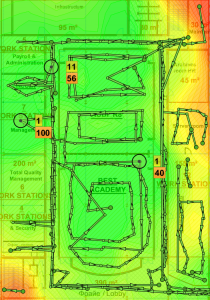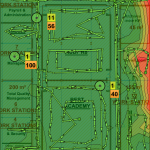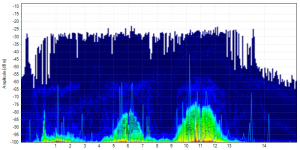We have over 10 years of professional experience in designing and building various types of Wireless Networks utilizing devices and solutions from multiple vendors – 3Com, Cisco, Mikrotik, Ruckus, Ubiquity, Proxim and many more.
Wireless for home and office
The requirements for different environments differ significantly. A good and clear understanding of the purpose of the network is a major requirement for a good design.
We utilize industry standard tools to design and predict the behavior of the future wireless network. Our expertise allows us to plan for a variety of factors in advance:
- Desired network throughput
- Capacity planning – the expected number and type of client devices that are going to use the network
- Radio frequency planning – optimal channel and frequency distribution, radio power adjustments
- Planning for redundancy
All these factors, complemented with extensive preliminary surveys, allow us to deliver the best possible wireless infrastructure – no matter for the home or office. And all this is done utilizing the optimal hardware for the purpose.
Wireless Site Surveys
Along as part of the design, we perform site surveys as a service. A detailed and comprehensive survey can aid in a number of situations:
- Wireless network design and planning
- Wireless network optimization
- Problem identification and resolution
- Interference issues – poor performance, intermittent connectivity problems etc.
We conduct site surveys using tools from one of the leading companies in the area – Ekahau – specifically the Ekahau Site Survey Pro™ toolkit, complemented with Ekahau Spectrum Analyzer™. These tools allow us to perform multi-floor wireless designs, wireless network surveys and spectrum analysis.
Our wireless site survey reports include:
- Network requirement compliance
- Identified network problems (according to the set requirements)
- RSSI – signal strength map
- Channel distribution mao
- Access point locations as determined by signal strength
- Rogue access point locations
- Signal to Noise Ratio map (SNR)
- Channel overlap map

- Data throughput (simulated and measured)
- Associated Access Point map – clearly showing the roaming template for the given environment
- Data rate – maximum available radio data rate at any given point
- Spectrum Channel Power map – shows the level of radio interference
- Spectrum Utilization chart – clearly shows the level of spectrum usage along the site
- Interference identification, optimization recommendations etc.
Spectrum Analysis
We usually perform a number of measurements in both 2.4GHz and 5GHz ISM bands for signs of external (non 802.11) interference. The spectrum analysis repor ts are usually huge and packed with information:
ts are usually huge and packed with information:
- Density views – show signal levels and utilization for the whole spectrum. These view allow for easy recognition of interfering sources – most of the modulations can be easily recognized on a density view.
- Waterfall graphs – invaluable tool to detect the duty cycle and bandwidth usage of different sources.
- Spectrum utilization graph – indicates the level of utilization along the spectrum channels and frequencies
- Networks, channels and devices – lists of all 802.11 networks and devices heard broadcasting during the spectrum recording.
Infrastructure Wireless
The thin boundary between a simple wireless network and the so called Infrastructure Wireless is not easily recognized every time. When we move from the home or the office space to the industrial environment all the requirements change. We have a huge experience in building industrial grade wireless solutions – from point to point and point to multipoint networks to large and complex, redundant mesh networks for some of the biggest industrial customers in Bulgaria.
Some of the key characteristics of every infrastructure wireless deployment include:
- Centralized management – controller based networks with built in redundancy
- Sophisticated and automatic Radio Resource Management technologies – allows for dynamic optimization of the network according to the operating environment
- Automatic load balancing – the controller itself balances the number of clients associated to every access point at any time
- High level of security – infrastructure solutions support all of the proven standards and approaches to wireless security
- Interference and rogue device detection – allows for dynamic optimization of the radio environment where the media is one for all.
- Extensive monitoring and reporting – every enterprise needs to reduce the operating costs of their networks. Our comprehensive solutions for monitoring and reporting help deliver manageability and insight to the network administrators

